Improving Prostate Image Segmentation Based on Equilibrium Optimizer and Cross-Entropy
Abstract
1. Introduction
2. Image Segmentation and Minimum Cross-Entropy
3. Equilibrium Optimizer
4. Minimum Cross-Entropy by EO for MRIs
4.1. Problem Formulation
4.2. Encoding
4.3. Initialization
4.4. MCE-EO Implementation
4.5. Thresholded Image
4.6. Computational Complexity
5. Experiments
5.1. Parameter Settings
5.2. Evaluating Image Quality
5.2.1. PSNR
5.2.2. SSIM
5.2.3. FSIM
5.3. Results from Standard Test Images
5.4. Results from Magnetic Resonance Prostate Images
5.5. Statistical Analysis of Standard Test Images
5.6. Segmentation Quality
6. Conclusions and Future Work
Future Work
Author Contributions
Funding
Data Availability Statement
Conflicts of Interest
References
- Krupa, K.; Bekiesińska-Figatowska, M. Artifacts in Magnetic Resonance Imaging. Pol. J. Radiol. 2015, 80, 93–106. [Google Scholar] [CrossRef] [PubMed]
- Ghose, S.; Oliver, A.; Martí, R.; Lladó, X.; Vilanova, J.C.; Freixenet, J.; Mitra, J.; Sidibé, D.; Meriaudeau, F. A survey of prostate segmentation methodologies in ultrasound, magnetic resonance and computed tomography images. Comput. Methods Programs Biomed. 2012, 108, 262–287. [Google Scholar] [CrossRef] [PubMed]
- Bray, F.; Laversanne, M.; Sung, H.; Ferlay, J.; Siegel, R.L.; Soerjomataram, I.; Jemal, A. Global cancer statistics 2022: GLOBOCAN estimates of incidence and mortality worldwide for 36 cancers in 185 countries. CA Cancer J. Clin. 2024, 74, 229–263. [Google Scholar] [CrossRef]
- Juneja, M.; Saini, S.K.; Gupta, J.; Garg, P.; Thakur, N.; Sharma, A.; Mehta, M.; Jindal, P. Survey of denoising, segmentation and classification of magnetic resonance imaging for prostate cancer. Multimed. Tools Appl. 2021, 80, 29199–29249. [Google Scholar] [CrossRef]
- Wang, G.; Li, Z.; Weng, G.; Chen, Y. An optimized denoised bias correction model with local pre-fitting function for weak boundary image segmentation. Signal Process. 2024, 220, 109448. [Google Scholar] [CrossRef]
- Otsu, N. A threshold selection method from gray-level histograms. IEEE Trans. Syst. Man Cybern. 1979, 9, 62–66. [Google Scholar] [CrossRef]
- Menendez, M. Shannon’s entropy in exponential families: Statistical applications. Appl. Math. Lett. 2000, 13, 37–42. [Google Scholar] [CrossRef]
- Kapur, J.N.; Sahoo, P.K.; Wong, A.K. A new method for gray-level picture thresholding using the entropy of the histogram. Comput. Vis. Graph. Image Process. 1985, 29, 273–285. [Google Scholar] [CrossRef]
- Tsallis, C. Computational applications of nonextensive statistical mechanics. J. Comput. Appl. Math. 2009, 227, 51–58. [Google Scholar] [CrossRef]
- Beadle, E.; Schroeder, J.; Moran, B.; Suvorova, S. An overview of Renyi Entropy and some potential applications. In Proceedings of the 2008 42nd Asilomar Conference on Signals, Systems and Computers, Pacific Grove, CA, USA, 26–29 October 2008; pp. 1698–1704. [Google Scholar]
- Li, C.H.; Lee, C. Minimum cross entropy thresholding. Pattern Recognit. 1993, 26, 617–625. [Google Scholar] [CrossRef]
- Tang, K.; Yuan, X.; Sun, T.; Yang, J.; Gao, S. An improved scheme for minimum cross entropy threshold selection based on genetic algorithm. Knowl.-Based Syst. 2011, 24, 1131–1138. [Google Scholar] [CrossRef]
- Kennedy, J.; Eberhart, R. Particle swarm optimization. In Proceedings of the ICNN’95-International Conference on Neural Networks, Perth, Australia, 27 November–1 December 1995; Volume 4, pp. 1942–1948. [Google Scholar]
- Avcibas, I.; Sankur, B.; Sayood, K. Statistical evaluation of image quality measures. J. Electron. Imaging 2002, 11, 206–223. [Google Scholar]
- Mirjalili, S.; Mirjalili, S.M.; Lewis, A. Grey wolf optimizer. Adv. Eng. Softw. 2014, 69, 46–61. [Google Scholar] [CrossRef]
- Liu, Y.; Mu, C.; Kou, W.; Liu, J. Modified particle swarm optimization-based multilevel thresholding for image segmentation. Soft Comput. 2015, 19, 1311–1327. [Google Scholar] [CrossRef]
- Khairuzzaman, A.K.M.; Chaudhury, S. Multilevel thresholding using grey wolf optimizer for image segmentation. Expert Syst. Appl. 2017, 86, 64–76. [Google Scholar] [CrossRef]
- Miller, B.L.; Goldberg, D.E. Genetic algorithms, selection schemes, and the varying effects of noise. Evol. Comput. 1996, 4, 113–131. [Google Scholar] [CrossRef]
- Naik, M.K.; Panda, R.; Abraham, A. An entropy minimization based multilevel colour thresholding technique for analysis of breast thermograms using equilibrium slime mould algorithm. Appl. Soft Comput. 2021, 113, 107955. [Google Scholar] [CrossRef]
- Houssein, E.H.; Emam, M.M.; Ali, A.A. Improved manta ray foraging optimization for multi-level thresholding using COVID-19 CT images. Neural Comput. Appl. 2021, 33, 16899–16919. [Google Scholar] [CrossRef]
- Avalos, O.; Ayala, E.; Wario, F.; Pérez-Cisneros, M. An accurate Cluster chaotic optimization approach for digital medical image segmentation. Neural Comput. Appl. 2021, 33, 10057–10091. [Google Scholar] [CrossRef]
- Panda, R.; Samantaray, L.; Das, A.; Agrawal, S.; Abraham, A. A novel evolutionary row class entropy based optimal multi-level thresholding technique for brain MR images. Expert Syst. Appl. 2021, 168, 114426. [Google Scholar] [CrossRef]
- Houssein, E.H.; Emam, M.M.; Ali, A.A. An efficient multilevel thresholding segmentation method for thermography breast cancer imaging based on improved chimp optimization algorithm. Expert Syst. Appl. 2021, 185, 115651. [Google Scholar] [CrossRef]
- Wolpert, D.H.; Macready, W.G. No free lunch theorems for optimization. IEEE Trans. Evol. Comput. 1997, 1, 67–82. [Google Scholar] [CrossRef]
- Faramarzi, A.; Heidarinejad, M.; Stephens, B.; Mirjalili, S. Equilibrium optimizer: A novel optimization algorithm. Knowl.-Based Syst. 2020, 191, 105190. [Google Scholar] [CrossRef]
- Abdul-hamied, D.T.; Shaheen, A.M.; Salem, W.A.; Gabr, W.I.; El-sehiemy, R.A. Equilibrium optimizer based multi dimensions operation of hybrid AC/DC grids. Alex. Eng. J. 2020, 59, 4787–4803. [Google Scholar] [CrossRef]
- Menesy, A.S.; Sultan, H.M.; Kamel, S. Extracting model parameters of proton exchange membrane fuel cell using equilibrium optimizer algorithm. In Proceedings of the 2020 International Youth Conference on Radio Electronics, Electrical and Power Engineering (REEPE), Moscow, Russia, 12–14 March 2020; pp. 1–7. [Google Scholar]
- Rabehi, A.; Nail, B.; Helal, H.; Douara, A.; Ziane, A.; Amrani, M.; Akkal, B.; Benamara, Z. Optimal estimation of Schottky diode parameters using a novel optimization algorithm: Equilibrium optimizer. Superlattices Microstruct. 2020, 146, 106665. [Google Scholar] [CrossRef]
- Abdel-Basset, M.; Mohamed, R.; Mirjalili, S.; Chakrabortty, R.K.; Ryan, M.J. Solar photovoltaic parameter estimation using an improved equilibrium optimizer. Sol. Energy 2020, 209, 694–708. [Google Scholar] [CrossRef]
- Yıldız, A.R.; Özkaya, H.; Yıldız, M.; Bureerat, S.; Yıldız, B.; Sait, S.M. The equilibrium optimization algorithm and the response surface-based metamodel for optimal structural design of vehicle components. Mater. Test. 2020, 62, 492–496. [Google Scholar] [CrossRef]
- Elsheikh, A.H.; Shehabeldeen, T.A.; Zhou, J.; Showaib, E.; Abd Elaziz, M. Prediction of laser cutting parameters for polymethylmethacrylate sheets using random vector functional link network integrated with equilibrium optimizer. J. Intell. Manuf. 2021, 32, 1377–1388. [Google Scholar] [CrossRef]
- Nguyen, T.; Nguyen, G.; Nguyen, B.M. EO-CNN: An enhanced CNN model trained by equilibrium optimization for traffic transportation prediction. Procedia Comput. Sci. 2020, 176, 800–809. [Google Scholar] [CrossRef]
- Gao, Y.; Zhou, Y.; Luo, Q. An efficient binary equilibrium optimizer algorithm for feature selection. IEEE Access 2020, 8, 140936–140963. [Google Scholar] [CrossRef]
- Zheng-Ming, G.; Juan, Z.; Su-Ruo, L.; Ru-Rong, H. The improved Equilibrium Optimization Algorithm with Tent Map. In Proceedings of the 2020 5th International Conference on Computer and Communication Systems (ICCCS), Shanghai, China, 15–18 May 2020; pp. 343–346. [Google Scholar]
- Zhao, J.; Gao, Z. The Improved Equilibrium Optimization Algorithm with Best Candidates. J. Phys. Conf. Ser. 2020, 1575, 012089. [Google Scholar] [CrossRef]
- Gupta, S.; Deep, K.; Mirjalili, S. An efficient equilibrium optimizer with mutation strategy for numerical optimization. Appl. Soft Comput. 2020, 96, 106542. [Google Scholar] [CrossRef]
- Abdel-Basset, M.; Mohamed, R.; Abouhawwash, M. Balanced multi-objective optimization algorithm using improvement based reference points approach. Swarm Evol. Comput. 2021, 60, 100791. [Google Scholar] [CrossRef]
- Abdel-Basset, M.; Chang, V.; Mohamed, R. A novel equilibrium optimization algorithm for multi-thresholding image segmentation problems. Neural Comput. Appl. 2021, 33, 10685–10718. [Google Scholar] [CrossRef]
- Wunnava, A.; Naik, M.K.; Panda, R.; Jena, B.; Abraham, A. A novel interdependence based multilevel thresholding technique using adaptive equilibrium optimizer. Eng. Appl. Artif. Intell. 2020, 94, 103836. [Google Scholar] [CrossRef]
- Gomes, G.F.; da Cunha, S.S.; Ancelotti, A.C. A sunflower optimization (SFO) algorithm applied to damage identification on laminated composite plates. Eng. Comput. 2019, 35, 619–626. [Google Scholar] [CrossRef]
- Mirjalili, S. SCA: A sine cosine algorithm for solving optimization problems. Knowl.-Based Syst. 2016, 96, 120–133. [Google Scholar] [CrossRef]
- Storn, R.; Price, K. Differential evolution–a simple and efficient heuristic for global optimization over continuous spaces. J. Glob. Optim. 1997, 11, 341–359. [Google Scholar] [CrossRef]
- Goldberg, D.E.; Holland, J.H. Genetic algorithms and machine learning. Mach. Learn. 1988, 3, 95–99. [Google Scholar] [CrossRef]
- Peterson, G.L. An O (n log n) unidirectional algorithm for the circular extrema problem. ACM Trans. Program. Lang. Syst. (TOPLAS) 1982, 4, 758–762. [Google Scholar] [CrossRef]
- Kullback, S. Information Theory and Statistics; Courier Corporation: North Chelmsford, MA, USA, 1997. [Google Scholar]
- Wang, Z.; Bovik, A.C.; Sheikh, H.R.; Simoncelli, E.P. Image quality assessment: From error visibility to structural similarity. IEEE Trans. Image Process. 2004, 13, 600–612. [Google Scholar] [CrossRef] [PubMed]
- Zhang, L.; Zhang, L.; Mou, X.; Zhang, D. FSIM: A feature similarity index for image quality assessment. IEEE Trans. Image Process. 2011, 20, 2378–2386. [Google Scholar] [CrossRef] [PubMed]
- Agrawal, S.; Panda, R.; Bhuyan, S.; Panigrahi, B.K. Tsallis entropy based optimal multilevel thresholding using cuckoo search algorithm. Swarm Evol. Comput. 2013, 11, 16–30. [Google Scholar] [CrossRef]
- Rodriguez-Esparza, E.; Zanella-Calzada, L.A.; Oliva, D.; Heidari, A.A.; Zaldivar, D.; Pérez-Cisneros, M.; Foong, L.K. An efficient Harris hawks-inspired image segmentation method. Expert Syst. Appl. 2020, 155, 113428. [Google Scholar] [CrossRef]
- The Ferenc Jolesz National Center for Image Guided Therapy, Harvard Medical School, B.H.H. Prostate MR Image Database. Available online: https://prostatemrimagedatabase.com/index.html (accessed on 15 March 2023).
- Theodorsson-Norheim, E. Kruskal-Wallis test: BASIC computer program to perform nonparametric one-way analysis of variance and multiple comparisons on ranks of several independent samples. Comput. Methods Programs Biomed. 1986, 23, 57–62. [Google Scholar] [CrossRef]
- Scheffe, H. The Analysis of Variance; John Wiley & Sons: Hoboken, NJ, USA, 1999; Volume 72. [Google Scholar]

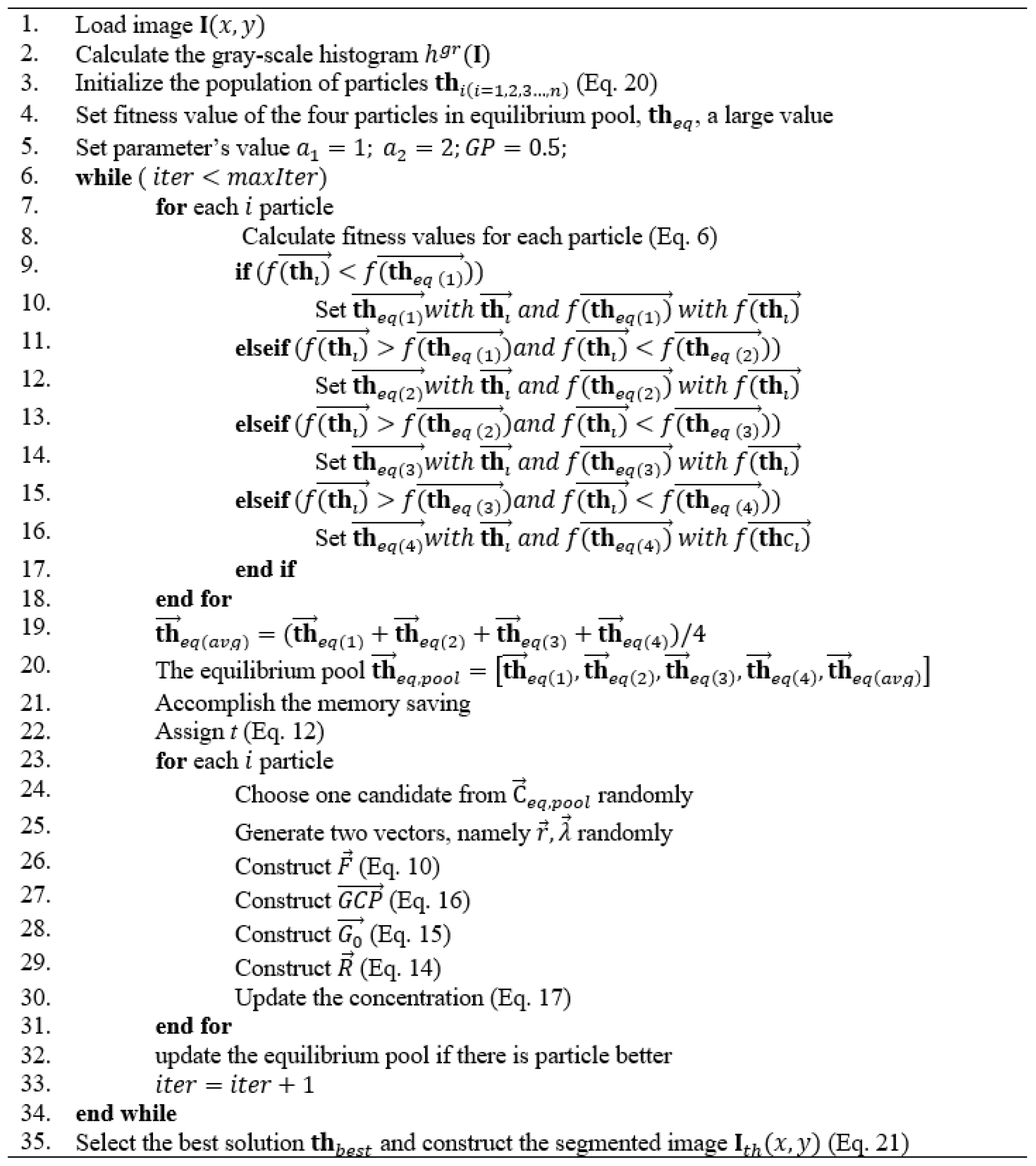

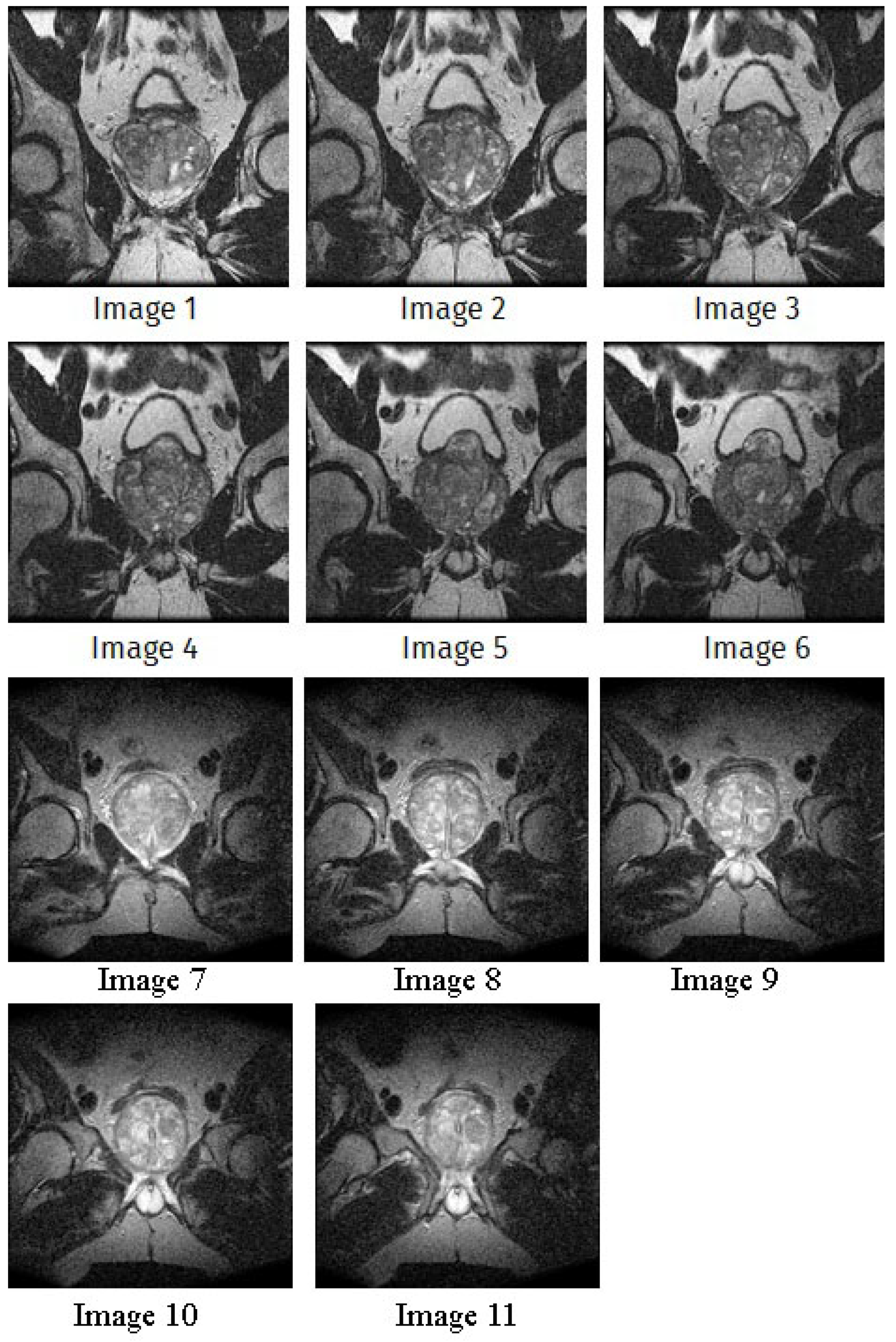
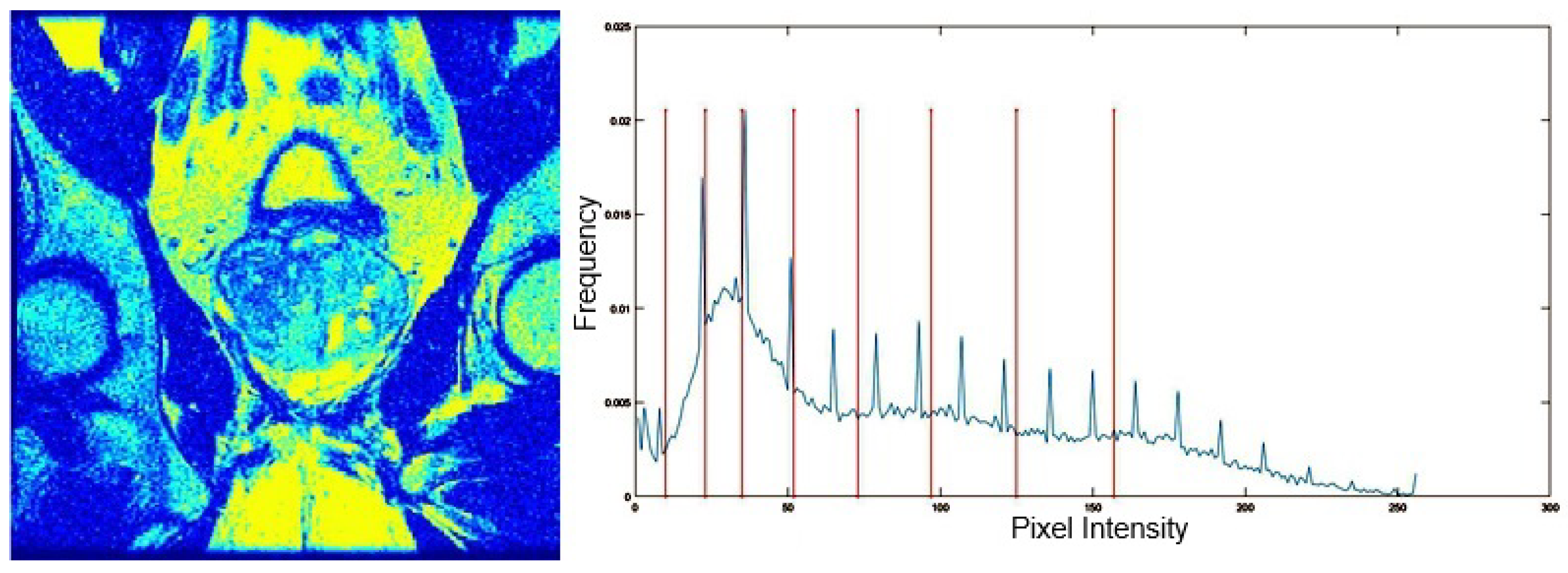
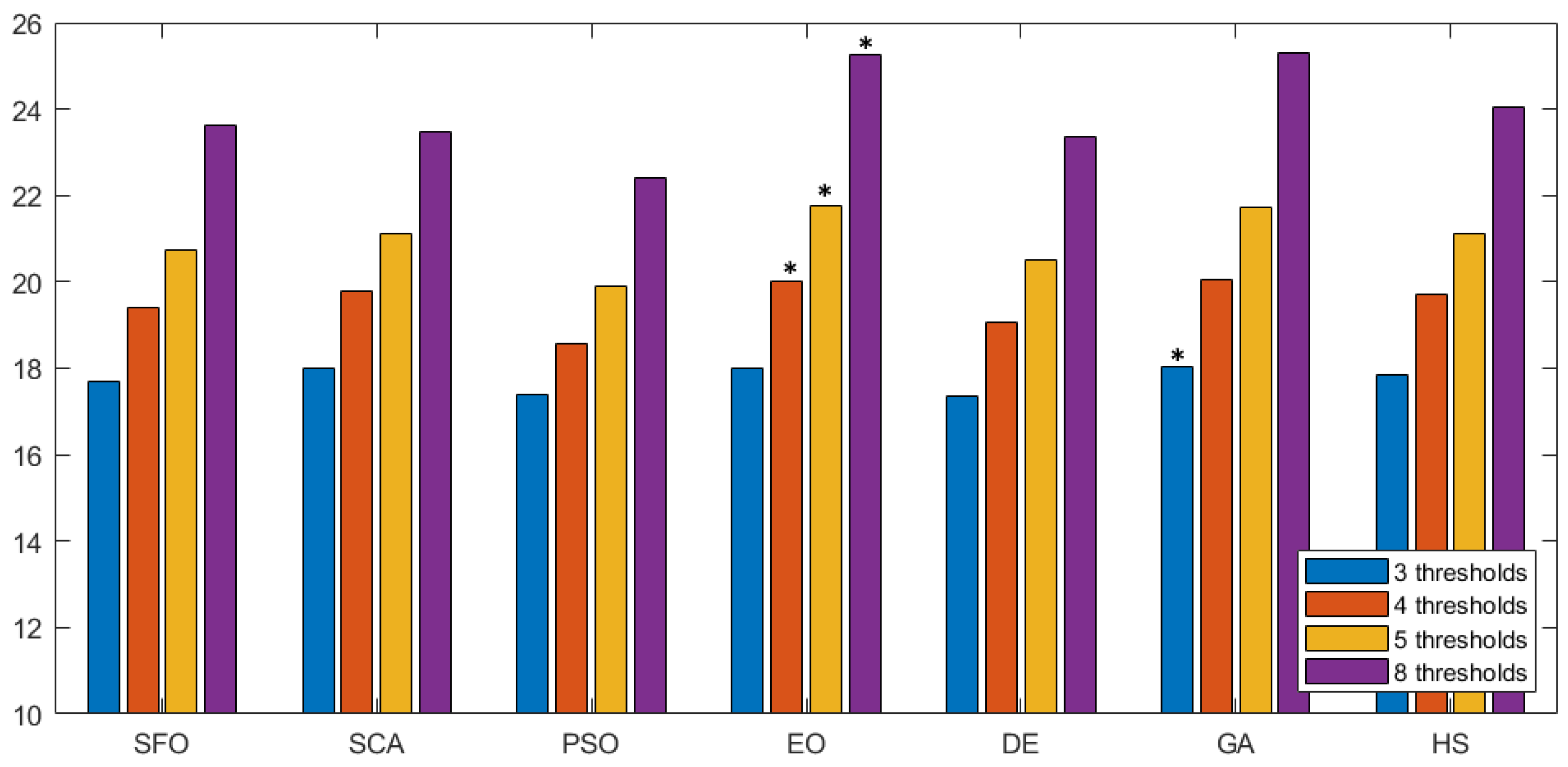
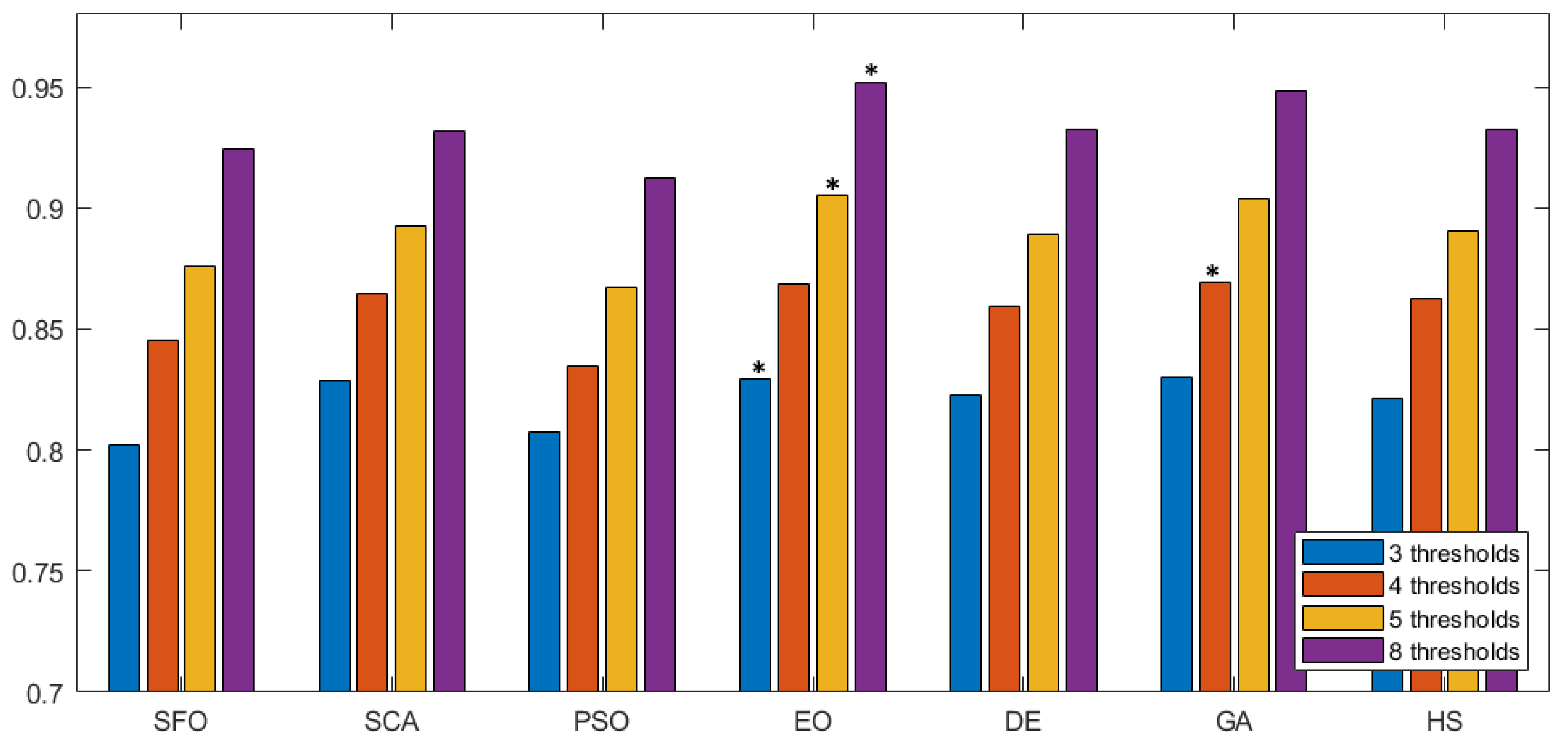
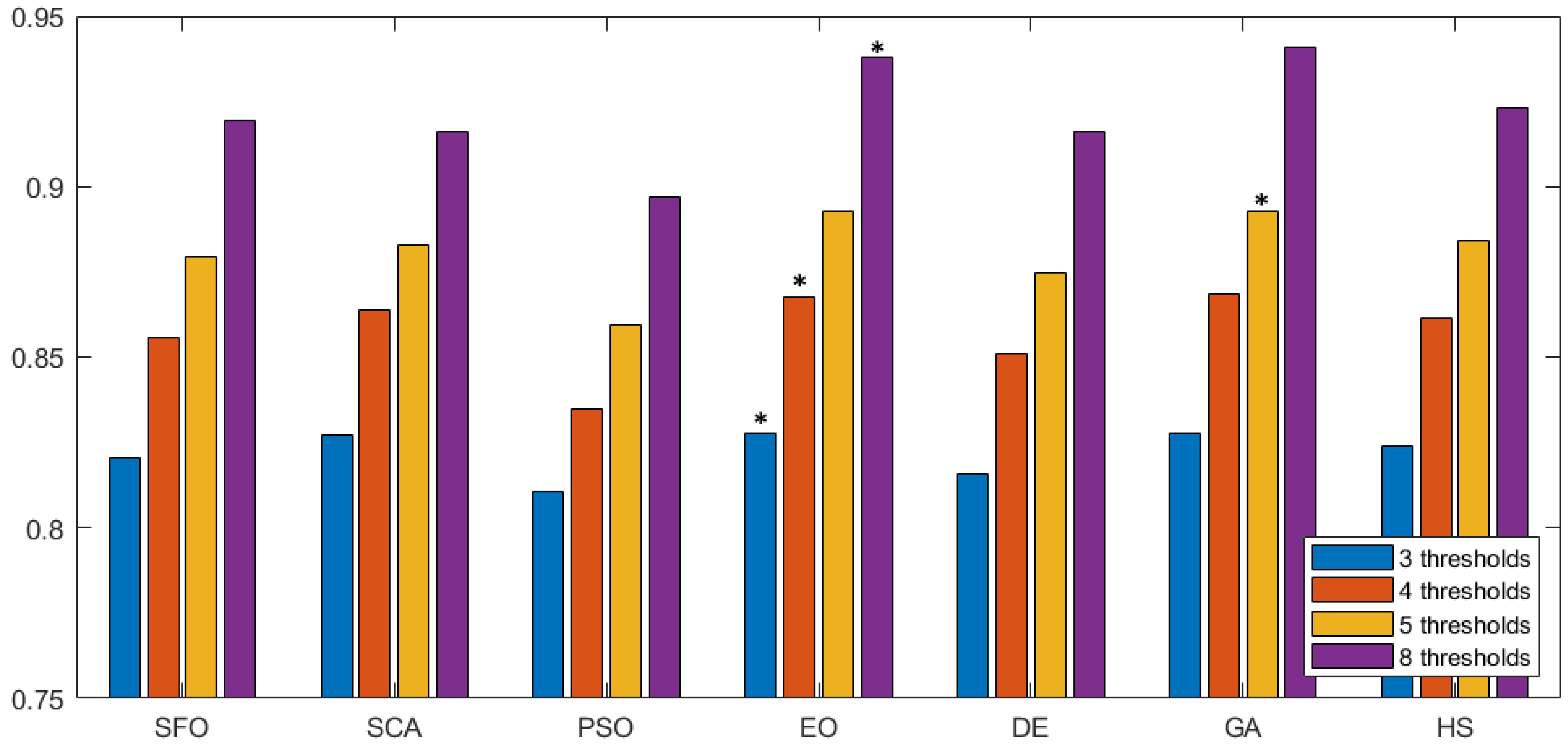
| Algorithm | Parameters | Value |
|---|---|---|
| Sunflower Optimization (SFO) Algorithm | Number of Sunflowers | 60 |
| Number of Experiments | 30 | |
| Pollination Values | 0.05 | |
| Mortality Rate, Best Values | 0.1 | |
| Survival Rate | 1 − (p + m) | |
| Iterations/Generations | 1000 | |
| Sine Cosine Algorithm (SCA) | Search Agents Number | 60 |
| Number of Experiments | 30 | |
| Iterations | 1000 | |
| Particle Swarm Optimization (PSO) | Social coefficient | 2 |
| Cognitive coefficient | 2 | |
| Velocity clamp | 2 | |
| Maximum inertia value | 0.2 | |
| Minimum inertia value | 0.9 | |
| Equilibrium Optimization (EO) | Number of runs | 20 |
| Population size | 30 | |
| The maximum number of iteration | 1000 | |
| a2 | 1 | |
| a1 | 2 | |
| Differential Evolution (DE) | Crossover Rate | 0.5 |
| Scale factor | 0.2 | |
| Genetic algorithm (GA) | CrossPercent | 70 |
| MutatPercent | 20 | |
| Hirschberg–Sinclair algorithm (HS) | Length of solution vector | 20 |
| HM Accepting Rate | 0.95 | |
| Pitch Adjusting rate | 0.40 |
| Image | nt = 3 | nt = 4 | nt = 5 | nt = 8 |
|---|---|---|---|---|
| Cameraman |  |  |  |  |
| Lenna |  |  |  |  |
| Baboon |  |  |  |  |
| Butterfly |  |  |  | 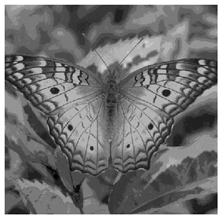 |
| Jet |  |  |  |  |
| Peppers | 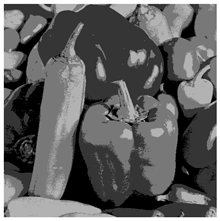 | 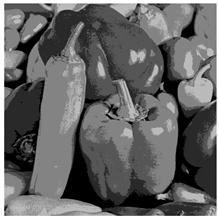 | 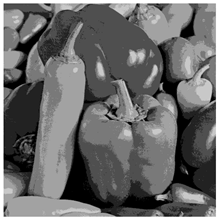 | 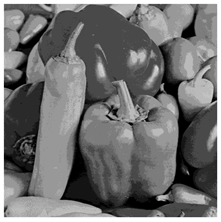 |
| Living Room |  |  |  |  |
| Blonde |  |  |  |  |
| Walk bridge | 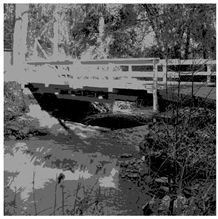 | 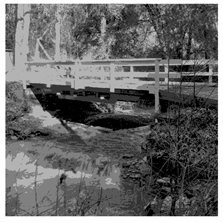 | 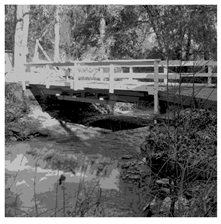 | 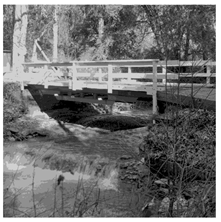 |
| Man |  |  |  |  |
| Lake | 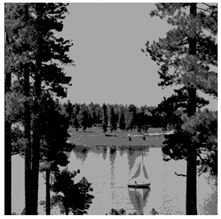 |  | 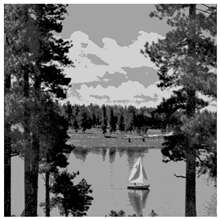 | 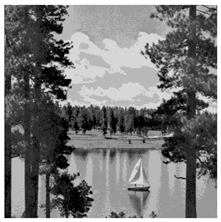 |
| SFO | SCA | PSO | EO | DE | GA | HS | |||||||||
|---|---|---|---|---|---|---|---|---|---|---|---|---|---|---|---|
| nt | Mean | Std | Mean | Std | Mean | Std | Mean | Std | Mean | Std | Mean | Std | Mean | Std | |
| Cameraman | 2 | 1.4117 | 0.01096 | 1.4018 | 0.00015 | 1.6651 | 0.17473 | 1.4017 | 0.00000 | 1.8029 | 0.03612 | 1.4022 | 0.00114 | 1.4477 | 0.08109 |
| 3 | 0.8469 | 0.06988 | 0.7657 | 0.00118 | 0.9549 | 0.07221 | 0.7638 | 0.00000 | 1.0170 | 0.08735 | 0.7649 | 0.00123 | 0.8745 | 0.14120 | |
| 4 | 0.6054 | 0.04051 | 0.5478 | 0.00534 | 0.8119 | 0.14055 | 0.5385 | 0.00000 | 0.7439 | 0.04196 | 0.5411 | 0.00247 | 0.5816 | 0.04190 | |
| 5 | 0.4578 | 0.03770 | 0.4274 | 0.02373 | 0.6349 | 0.09115 | 0.4040 | 0.00248 | 0.6161 | 0.07341 | 0.4102 | 0.00488 | 0.4449 | 0.04243 | |
| 8 | 0.2606 | 0.03200 | 0.2767 | 0.03286 | 0.3809 | 0.06041 | 0.2064 | 0.00179 | 0.3664 | 0.02945 | 0.2101 | 0.00481 | 0.2547 | 0.03730 | |
| 16 | 0.1025 | 0.01772 | 0.1278 | 0.01575 | 0.1524 | 0.02066 | 0.0609 | 0.00428 | 0.1571 | 0.02406 | 0.0710 | 0.00366 | 0.1113 | 0.01438 | |
| 32 | 0.0404 | 0.00601 | 0.0507 | 0.00650 | 0.0567 | 0.00783 | 0.0186 | 0.00170 | 0.0589 | 0.00774 | 0.0235 | 0.00151 | 0.0398 | 0.00498 | |
| SFO | SCA | PSO | EO | DE | GA | HS | |||||||||
| nt | Mean | Std | Mean | Std | Mean | Std | Mean | Std | Mean | Std | Mean | Std | Mean | Std | |
| Lenna | 2 | 1.3773 | 0.01259 | 1.3664 | 0.00019 | 1.5693 | 0.14865 | 1.3663 | 0.00000 | 2.0904 | 0.01884 | 1.3666 | 0.00074 | 1.4117 | 0.05143 |
| 3 | 0.8373 | 0.14342 | 0.7204 | 0.00227 | 0.9636 | 0.05595 | 0.7174 | 0.00000 | 1.1725 | 0.04331 | 0.7190 | 0.00160 | 0.7610 | 0.05498 | |
| 4 | 0.5989 | 0.08566 | 0.5133 | 0.08311 | 0.7460 | 0.10954 | 0.4687 | 0.00000 | 0.8508 | 0.04771 | 0.4737 | 0.00431 | 0.5256 | 0.06262 | |
| 5 | 0.4730 | 0.09972 | 0.3751 | 0.04824 | 0.6213 | 0.11400 | 0.3272 | 0.00012 | 0.6493 | 0.07692 | 0.3377 | 0.00456 | 0.3901 | 0.05983 | |
| 8 | 0.2775 | 0.04431 | 0.2478 | 0.03314 | 0.3437 | 0.05068 | 0.1609 | 0.00948 | 0.3879 | 0.04012 | 0.1771 | 0.00970 | 0.2333 | 0.04870 | |
| 16 | 0.1004 | 0.01243 | 0.1159 | 0.01462 | 0.1425 | 0.02351 | 0.0558 | 0.00492 | 0.1625 | 0.01876 | 0.0649 | 0.00413 | 0.1073 | 0.01446 | |
| 32 | 0.0354 | 0.00503 | 0.0444 | 0.00462 | 0.0526 | 0.00660 | 0.0175 | 0.00160 | 0.0576 | 0.00691 | 0.0208 | 0.00097 | 0.0404 | 0.00462 | |
| SFO | SCA | PSO | EO | DE | GA | HS | |||||||||
| nt | Mean | Std | Mean | Std | Mean | Std | Mean | Std | Mean | Std | Mean | Std | Mean | Std | |
| Baboon | 2 | 1.2168 | 0.01205 | 1.2050 | 0.00018 | 1.3544 | 0.16955 | 1.2049 | 0.00000 | 1.3406 | 0.01567 | 1.2055 | 0.00084 | 1.2335 | 0.06351 |
| 3 | 0.8669 | 0.11554 | 0.7433 | 0.00184 | 0.9427 | 0.07690 | 0.7407 | 0.00000 | 0.8646 | 0.05344 | 0.7426 | 0.00239 | 0.7963 | 0.07087 | |
| 4 | 0.6093 | 0.10167 | 0.5193 | 0.00557 | 0.7613 | 0.12657 | 0.5073 | 0.00001 | 0.6382 | 0.07473 | 0.5143 | 0.00493 | 0.5565 | 0.05481 | |
| 5 | 0.4853 | 0.07232 | 0.4100 | 0.04572 | 0.6102 | 0.08525 | 0.3681 | 0.00017 | 0.4888 | 0.04138 | 0.3821 | 0.00829 | 0.4149 | 0.03846 | |
| 8 | 0.2767 | 0.04355 | 0.2663 | 0.02277 | 0.3715 | 0.07544 | 0.1840 | 0.00272 | 0.2880 | 0.03291 | 0.2006 | 0.00672 | 0.2524 | 0.03568 | |
| 16 | 0.0978 | 0.01556 | 0.1190 | 0.01455 | 0.1478 | 0.02284 | 0.0595 | 0.00415 | 0.1199 | 0.01372 | 0.0694 | 0.00321 | 0.1087 | 0.01361 | |
| 32 | 0.0322 | 0.00674 | 0.0464 | 0.00546 | 0.0540 | 0.00655 | 0.0187 | 0.00149 | 0.0432 | 0.00454 | 0.0211 | 0.00084 | 0.0417 | 0.00496 | |
| SFO | SCA | PSO | EO | DE | GA | HS | |||||||||
| nt | Mean | Std | Mean | Std | Mean | Std | Mean | Std | Mean | Std | Mean | Std | Mean | Std | |
| Man | 2 | 2.7579 | 0.01938 | 2.7354 | 0.00000 | 3.2564 | 0.52431 | 2.7354 | 0.00000 | 2.7639 | 0.05671 | 2.7360 | 0.00117 | 2.8214 | 0.11497 |
| 3 | 1.8046 | 0.15348 | 1.6243 | 0.00172 | 2.0578 | 0.34861 | 1.6222 | 0.00000 | 1.7008 | 0.07634 | 1.6251 | 0.00437 | 1.6996 | 0.13574 | |
| 4 | 1.2426 | 0.16414 | 1.0388 | 0.00700 | 1.6754 | 0.28346 | 1.0255 | 0.00000 | 1.2238 | 0.18571 | 1.0443 | 0.01609 | 1.2176 | 0.14436 | |
| 5 | 0.9323 | 0.09134 | 0.7820 | 0.01330 | 1.0223 | 0.13226 | 0.7509 | 0.00073 | 0.9512 | 0.10419 | 0.7724 | 0.02051 | 0.9494 | 0.13691 | |
| 8 | 0.5177 | 0.05345 | 0.4969 | 0.05141 | 0.7609 | 0.14181 | 0.3612 | 0.00555 | 0.5861 | 0.07717 | 0.4101 | 0.01812 | 0.5736 | 0.09095 | |
| 16 | 0.2047 | 0.03880 | 0.2434 | 0.02906 | 0.3100 | 0.06165 | 0.1085 | 0.00661 | 0.2373 | 0.03906 | 0.1466 | 0.01190 | 0.2363 | 0.03691 | |
| 32 | 0.0733 | 0.01163 | 0.0995 | 0.01565 | 0.1244 | 0.02077 | 0.0324 | 0.00314 | 0.0937 | 0.01297 | 0.0473 | 0.00526 | 0.0898 | 0.01440 | |
| SFO | SCA | PSO | EO | DE | GA | HS | |||||||||
| nt | Mean | Std | Mean | Std | Mean | Std | Mean | Std | Mean | Std | Mean | Std | Mean | Std | |
| Jet | 2 | 0.8261 | 0.00680 | 0.8209 | 0.00005 | 0.8803 | 0.04723 | 0.8209 | 0.00000 | 1.1744 | 0.01227 | 0.8210 | 0.00027 | 0.8287 | 0.00900 |
| 3 | 0.5408 | 0.03280 | 0.5102 | 0.00097 | 0.6280 | 0.08462 | 0.5086 | 0.00000 | 0.7362 | 0.02088 | 0.5089 | 0.00031 | 0.5223 | 0.01465 | |
| 4 | 0.3855 | 0.04167 | 0.3428 | 0.00398 | 0.4628 | 0.06827 | 0.3369 | 0.00000 | 0.5104 | 0.03430 | 0.3386 | 0.00156 | 0.3599 | 0.02291 | |
| 5 | 0.3032 | 0.04318 | 0.2555 | 0.02571 | 0.3740 | 0.05803 | 0.2292 | 0.00007 | 0.3987 | 0.03661 | 0.2327 | 0.00258 | 0.2721 | 0.03798 | |
| 8 | 0.1655 | 0.02981 | 0.1644 | 0.02274 | 0.2194 | 0.03520 | 0.1107 | 0.00446 | 0.2164 | 0.02063 | 0.1147 | 0.00453 | 0.1420 | 0.02595 | |
| 16 | 0.0680 | 0.00965 | 0.0756 | 0.01122 | 0.0891 | 0.01411 | 0.0347 | 0.00289 | 0.0846 | 0.00740 | 0.0396 | 0.00165 | 0.0612 | 0.00843 | |
| 32 | 0.0221 | 0.00335 | 0.0288 | 0.00344 | 0.0309 | 0.00483 | 0.0113 | 0.00088 | 0.0310 | 0.00262 | 0.0127 | 0.00060 | 0.0238 | 0.00246 | |
| SFO | SCA | PSO | EO | DE | GA | HS | |||||||||
| nt | Mean | Std | Mean | Std | Mean | Std | Mean | Std | Mean | Std | Mean | Std | Mean | Std | |
| Peppers | 2 | 1.7490 | 0.02017 | 1.7333 | 0.00012 | 2.0570 | 0.27966 | 1.7332 | 0.00000 | 1.7507 | 0.02651 | 1.7334 | 0.00032 | 1.7827 | 0.09471 |
| 3 | 1.2225 | 0.04887 | 1.1629 | 0.00150 | 1.4030 | 0.15742 | 1.1609 | 0.00000 | 1.2141 | 0.05578 | 1.1623 | 0.00251 | 1.1970 | 0.02819 | |
| 4 | 0.8439 | 0.10218 | 0.7338 | 0.00688 | 0.9587 | 0.07184 | 0.7222 | 0.00000 | 0.8553 | 0.12449 | 0.7274 | 0.00364 | 0.7972 | 0.08052 | |
| 5 | 0.6524 | 0.06552 | 0.5904 | 0.04739 | 0.8468 | 0.10640 | 0.5458 | 0.00501 | 0.6715 | 0.06556 | 0.5568 | 0.01081 | 0.6332 | 0.06993 | |
| 8 | 0.3488 | 0.03234 | 0.3616 | 0.03461 | 0.4765 | 0.07546 | 0.2712 | 0.00137 | 0.3855 | 0.04521 | 0.2893 | 0.00729 | 0.3572 | 0.04407 | |
| 16 | 0.1191 | 0.01599 | 0.1627 | 0.01641 | 0.2037 | 0.03138 | 0.0819 | 0.00615 | 0.1625 | 0.01691 | 0.0917 | 0.00434 | 0.1428 | 0.01652 | |
| 32 | 0.0399 | 0.00540 | 0.0644 | 0.00627 | 0.0701 | 0.00975 | 0.0239 | 0.00144 | 0.0561 | 0.00637 | 0.0263 | 0.00096 | 0.0514 | 0.00679 | |
| SFO | SCA | PSO | EO | DE | GA | HS | |||||||||
| nt | Mean | Std | Mean | Std | Mean | Std | Mean | Std | Mean | Std | Mean | Std | Mean | Std | |
| Living Room | 2 | 1.8863 | 0.01391 | 1.8735 | 0.00010 | 2.0615 | 0.13908 | 1.8735 | 0.00000 | 1.8934 | 0.02997 | 1.8741 | 0.00107 | 1.9206 | 0.06988 |
| 3 | 1.3089 | 0.09341 | 1.1719 | 0.00104 | 1.4043 | 0.17023 | 1.1704 | 0.00000 | 1.2133 | 0.04039 | 1.1714 | 0.00084 | 1.2182 | 0.08456 | |
| 4 | 0.8777 | 0.08782 | 0.7674 | 0.00546 | 0.9637 | 0.06581 | 0.7571 | 0.00000 | 0.8441 | 0.07446 | 0.7621 | 0.00534 | 0.8126 | 0.07143 | |
| 5 | 0.6526 | 0.06112 | 0.5884 | 0.06332 | 0.7911 | 0.10943 | 0.5391 | 0.00003 | 0.6560 | 0.06048 | 0.5533 | 0.00552 | 0.6214 | 0.08986 | |
| 8 | 0.3827 | 0.04906 | 0.3560 | 0.03995 | 0.4671 | 0.07450 | 0.2548 | 0.00333 | 0.3618 | 0.03683 | 0.2726 | 0.00519 | 0.3518 | 0.05181 | |
| 16 | 0.1450 | 0.02095 | 0.1580 | 0.01744 | 0.1800 | 0.02144 | 0.0790 | 0.00585 | 0.1458 | 0.01802 | 0.0877 | 0.00333 | 0.1358 | 0.01611 | |
| 32 | 0.0438 | 0.00603 | 0.0591 | 0.00678 | 0.0677 | 0.00827 | 0.0230 | 0.00152 | 0.0548 | 0.00662 | 0.0252 | 0.00123 | 0.0503 | 0.00557 | |
| SFO | SCA | PSO | EO | DE | GA | HS | |||||||||
| nt | Mean | Std | Mean | Std | Mean | Std | Mean | Std | Mean | Std | Mean | Std | Mean | Std | |
| Blonde | 2 | 1.5260 | 0.00606 | 1.5194 | 0.00002 | 1.6165 | 0.07292 | 1.5194 | 0.00000 | 1.9460 | 0.04128 | 1.5201 | 0.00119 | 1.5991 | 0.07200 |
| 3 | 0.8453 | 0.06209 | 0.7823 | 0.00120 | 0.9486 | 0.06697 | 0.7803 | 0.00000 | 1.0230 | 0.02881 | 0.7804 | 0.00017 | 0.8219 | 0.09166 | |
| 4 | 0.6174 | 0.06585 | 0.5389 | 0.00517 | 0.7670 | 0.11354 | 0.5279 | 0.00000 | 0.7390 | 0.05686 | 0.5292 | 0.00173 | 0.5605 | 0.05526 | |
| 5 | 0.4721 | 0.06131 | 0.4072 | 0.02812 | 0.6041 | 0.08157 | 0.3767 | 0.00001 | 0.5620 | 0.03376 | 0.3859 | 0.00623 | 0.4360 | 0.03942 | |
| 8 | 0.2609 | 0.03099 | 0.2488 | 0.02602 | 0.3293 | 0.06367 | 0.1692 | 0.00633 | 0.2911 | 0.03381 | 0.1819 | 0.00874 | 0.2317 | 0.03366 | |
| 16 | 0.0947 | 0.01182 | 0.1124 | 0.01549 | 0.1351 | 0.01792 | 0.0511 | 0.00414 | 0.1057 | 0.01057 | 0.0622 | 0.00384 | 0.0969 | 0.01390 | |
| 32 | 0.0343 | 0.00557 | 0.0435 | 0.00647 | 0.0487 | 0.00785 | 0.0159 | 0.00133 | 0.0374 | 0.00434 | 0.0186 | 0.00089 | 0.0358 | 0.00458 | |
| SFO | SCA | PSO | EO | DE | GA | HS | |||||||||
| nt | Mean | Std | Mean | Std | Mean | Std | Mean | Std | Mean | Std | Mean | Std | Mean | Std | |
| Walk Bridge | 2 | 2.4590 | 0.01534 | 2.4430 | 0.00000 | 2.6081 | 0.15354 | 2.4430 | 0.00000 | 2.4595 | 0.02102 | 2.4435 | 0.00148 | 2.4920 | 0.08550 |
| 3 | 1.6342 | 0.09068 | 1.4715 | 0.00159 | 1.7945 | 0.21712 | 1.4698 | 0.00000 | 1.5030 | 0.03612 | 1.4701 | 0.00056 | 1.5317 | 0.10586 | |
| 4 | 1.1647 | 0.07638 | 1.0233 | 0.00506 | 1.3004 | 0.12764 | 1.0145 | 0.00002 | 1.1007 | 0.06774 | 1.0169 | 0.00204 | 1.0661 | 0.05113 | |
| 5 | 0.9076 | 0.09779 | 0.7558 | 0.02761 | 0.9680 | 0.06440 | 0.7285 | 0.00182 | 0.8412 | 0.06239 | 0.7302 | 0.00332 | 0.7871 | 0.05790 | |
| 8 | 0.4764 | 0.06096 | 0.4499 | 0.04801 | 0.5923 | 0.09927 | 0.3327 | 0.00176 | 0.4668 | 0.04121 | 0.3458 | 0.00709 | 0.4318 | 0.05728 | |
| 16 | 0.1683 | 0.02217 | 0.1897 | 0.02285 | 0.2070 | 0.03383 | 0.0925 | 0.00675 | 0.1736 | 0.01663 | 0.0934 | 0.00375 | 0.1568 | 0.02784 | |
| 32 | 0.0517 | 0.00773 | 0.0641 | 0.00747 | 0.0684 | 0.00880 | 0.0254 | 0.00170 | 0.0600 | 0.00861 | 0.0233 | 0.00077 | 0.0499 | 0.00617 | |
| SFO | SCA | PSO | EO | DE | GA | HS | |||||||||
| nt | Mean | Std | Mean | Std | Mean | Std | Mean | Std | Mean | Std | Mean | Std | Mean | Std | |
| Butterfly | 2 | 1.1879 | 0.01958 | 1.1752 | 0.00000 | 1.4027 | 0.22217 | 1.1752 | 0.00000 | 1.7714 | 0.01460 | 1.1755 | 0.00065 | 1.2016 | 0.03019 |
| 3 | 0.7805 | 0.12572 | 0.6259 | 0.00227 | 0.8734 | 0.12416 | 0.6228 | 0.00000 | 1.0249 | 0.07751 | 0.6249 | 0.00234 | 0.6804 | 0.08202 | |
| 4 | 0.5489 | 0.08162 | 0.4347 | 0.05196 | 0.6900 | 0.13235 | 0.4116 | 0.00000 | 0.7238 | 0.05561 | 0.4213 | 0.00742 | 0.4746 | 0.05711 | |
| 5 | 0.4154 | 0.06613 | 0.3588 | 0.04880 | 0.5441 | 0.13045 | 0.3017 | 0.00000 | 0.5722 | 0.07480 | 0.3160 | 0.00768 | 0.3723 | 0.06380 | |
| 8 | 0.2535 | 0.02965 | 0.2270 | 0.02708 | 0.3345 | 0.07068 | 0.1417 | 0.00661 | 0.3248 | 0.04042 | 0.1658 | 0.01194 | 0.2299 | 0.04721 | |
| 16 | 0.1014 | 0.01845 | 0.1122 | 0.01172 | 0.1322 | 0.02140 | 0.0512 | 0.00517 | 0.1339 | 0.01636 | 0.0621 | 0.00313 | 0.1001 | 0.01548 | |
| 32 | 0.0347 | 0.00723 | 0.0421 | 0.00549 | 0.0530 | 0.00581 | 0.0160 | 0.00169 | 0.0495 | 0.00618 | 0.0199 | 0.00110 | 0.0403 | 0.00382 | |
| SFO | SCA | PSO | EO | DE | GA | HS | |||||||||
| nt | Mean | Std | Mean | Std | Mean | Std | Mean | Std | Mean | Std | Mean | Std | Mean | Std | |
| Lake | 2 | 1.4479 | 0.01300 | 1.4383 | 0.00011 | 1.6250 | 0.13768 | 1.4382 | 0.00000 | 1.5808 | 0.02428 | 1.4386 | 0.00069 | 1.4863 | 0.10538 |
| 3 | 1.0189 | 0.03851 | 0.9644 | 0.00138 | 0.9995 | 0.00187 | 0.9625 | 0.00000 | 1.0782 | 0.02996 | 0.9628 | 0.00037 | 0.9916 | 0.04004 | |
| 4 | 0.7319 | 0.06024 | 0.6436 | 0.00687 | 0.8416 | 0.10998 | 0.6313 | 0.00003 | 0.7722 | 0.05688 | 0.6329 | 0.00132 | 0.6815 | 0.05902 | |
| 5 | 0.5566 | 0.05256 | 0.4886 | 0.06373 | 0.7024 | 0.12129 | 0.4363 | 0.00020 | 0.5588 | 0.05048 | 0.4391 | 0.00329 | 0.4853 | 0.04585 | |
| 8 | 0.3018 | 0.04395 | 0.2869 | 0.03832 | 0.4203 | 0.07043 | 0.2013 | 0.00277 | 0.3286 | 0.03865 | 0.2115 | 0.00861 | 0.2607 | 0.03733 | |
| 16 | 0.1098 | 0.01976 | 0.1390 | 0.01497 | 0.1591 | 0.02422 | 0.0669 | 0.00407 | 0.1308 | 0.01341 | 0.0743 | 0.00409 | 0.1177 | 0.01813 | |
| 32 | 0.0384 | 0.00701 | 0.0511 | 0.00435 | 0.0559 | 0.00560 | 0.0212 | 0.00201 | 0.0474 | 0.00542 | 0.0227 | 0.00109 | 0.0441 | 0.00431 | |
| SFO | SCA | PSO | EO | DE | GA | HS | Ranking | |||||||||
|---|---|---|---|---|---|---|---|---|---|---|---|---|---|---|---|---|
| Image | nt | Mean | Std | Mean | Std | Mean | Std | Mean | Std | Mean | Std | Mean | Std | Mean | Std | |
| 1 | 3 | 0.8469 | 0.0699 | 0.7657 | 0.0012 | 0.9549 | 0.0722 | 0.7638 | 0.0000 | 1.0170 | 0.0873 | 0.7649 | 0.0012 | 0.8745 | 0.1412 |  |
| 4 | 0.6054 | 0.0405 | 0.5478 | 0.0053 | 0.8119 | 0.1406 | 0.5385 | 0.0000 | 0.7439 | 0.0420 | 0.5411 | 0.0025 | 0.5816 | 0.0419 |  | |
| 5 | 0.4578 | 0.0377 | 0.4274 | 0.0237 | 0.6349 | 0.0911 | 0.4040 | 0.0025 | 0.6161 | 0.0734 | 0.4102 | 0.0049 | 0.4449 | 0.0424 |  | |
| 8 | 0.2606 | 0.0320 | 0.2767 | 0.0329 | 0.3809 | 0.0604 | 0.2064 | 0.0018 | 0.3664 | 0.0295 | 0.2101 | 0.0048 | 0.2547 | 0.0373 |  | |
| 2 | 3 | 0.8373 | 0.1434 | 0.7204 | 0.0023 | 0.9636 | 0.0559 | 0.7174 | 0.0000 | 1.1725 | 0.0433 | 0.7190 | 0.0016 | 0.7610 | 0.0550 |  |
| 4 | 0.5989 | 0.0857 | 0.5133 | 0.0831 | 0.7460 | 0.1095 | 0.4687 | 0.0000 | 0.8508 | 0.0477 | 0.4737 | 0.0043 | 0.5256 | 0.0626 |  | |
| 5 | 0.4730 | 0.0997 | 0.3751 | 0.0482 | 0.6213 | 0.1140 | 0.3272 | 0.0001 | 0.6493 | 0.0769 | 0.3377 | 0.0046 | 0.3901 | 0.0598 |  | |
| 8 | 0.2775 | 0.0443 | 0.2478 | 0.0331 | 0.3437 | 0.0507 | 0.1609 | 0.0095 | 0.3879 | 0.0401 | 0.1771 | 0.0097 | 0.2333 | 0.0487 |  | |
| 3 | 3 | 0.8669 | 0.1155 | 0.7433 | 0.0018 | 0.9427 | 0.0769 | 0.7407 | 0.0000 | 0.8646 | 0.0534 | 0.7426 | 0.0024 | 0.7963 | 0.0709 |  |
| 4 | 0.6093 | 0.1017 | 0.5193 | 0.0056 | 0.7613 | 0.1266 | 0.5073 | 0.0000 | 0.6382 | 0.0747 | 0.5143 | 0.0049 | 0.5565 | 0.0548 |  | |
| 5 | 0.4853 | 0.0723 | 0.4100 | 0.0457 | 0.6102 | 0.0852 | 0.3681 | 0.0002 | 0.4888 | 0.0414 | 0.3821 | 0.0083 | 0.4149 | 0.0385 |  | |
| 8 | 0.2767 | 0.0436 | 0.2663 | 0.0228 | 0.3715 | 0.0754 | 0.1840 | 0.0027 | 0.2880 | 0.0329 | 0.2006 | 0.0067 | 0.2524 | 0.0357 |  | |
| 4 | 3 | 1.8046 | 0.1535 | 1.6243 | 0.0017 | 2.0578 | 0.3486 | 1.6222 | 0.0000 | 1.7008 | 0.0763 | 1.6251 | 0.0044 | 1.6996 | 0.1357 |  |
| 4 | 1.2426 | 0.1641 | 1.0388 | 0.0070 | 1.6754 | 0.2835 | 1.0255 | 0.0000 | 1.2238 | 0.1857 | 1.0443 | 0.0161 | 1.2176 | 0.1444 |  | |
| 5 | 0.9323 | 0.0913 | 0.7820 | 0.0133 | 1.0223 | 0.1323 | 0.7509 | 0.0007 | 0.9512 | 0.1042 | 0.7724 | 0.0205 | 0.9494 | 0.1369 |  | |
| 8 | 0.5177 | 0.0534 | 0.4969 | 0.0514 | 0.7609 | 0.1418 | 0.3612 | 0.0055 | 0.5861 | 0.0772 | 0.4101 | 0.0181 | 0.5736 | 0.0910 |  | |
| 5 | 3 | 0.5408 | 0.0328 | 0.5102 | 0.0010 | 0.6280 | 0.0846 | 0.5086 | 0.0000 | 0.7362 | 0.0209 | 0.5089 | 0.0003 | 0.5223 | 0.0147 |  |
| 4 | 0.3855 | 0.0417 | 0.3428 | 0.0040 | 0.4628 | 0.0683 | 0.3369 | 0.0000 | 0.5104 | 0.0343 | 0.3386 | 0.0016 | 0.3599 | 0.0229 |  | |
| 5 | 0.3032 | 0.0432 | 0.2555 | 0.0257 | 0.3740 | 0.0580 | 0.2292 | 0.0001 | 0.3987 | 0.0366 | 0.2327 | 0.0026 | 0.2721 | 0.0380 |  | |
| 8 | 0.1655 | 0.0298 | 0.1644 | 0.0227 | 0.2194 | 0.0352 | 0.1107 | 0.0045 | 0.2164 | 0.0206 | 0.1147 | 0.0045 | 0.1420 | 0.0260 |  | |
| 6 | 3 | 1.2225 | 0.0489 | 1.1629 | 0.0015 | 1.4030 | 0.1574 | 1.1609 | 0.0000 | 1.2141 | 0.0558 | 1.1623 | 0.0025 | 1.1970 | 0.0282 |  |
| 4 | 0.8439 | 0.1022 | 0.7338 | 0.0069 | 0.9587 | 0.0718 | 0.7222 | 0.0000 | 0.8553 | 0.1245 | 0.7274 | 0.0036 | 0.7972 | 0.0805 |  | |
| 5 | 0.6524 | 0.0655 | 0.5904 | 0.0474 | 0.8468 | 0.1064 | 0.5458 | 0.0050 | 0.6715 | 0.0656 | 0.5568 | 0.0108 | 0.6332 | 0.0699 |  | |
| 8 | 0.3488 | 0.0323 | 0.3616 | 0.0346 | 0.4765 | 0.0755 | 0.2712 | 0.0014 | 0.3855 | 0.0452 | 0.2893 | 0.0073 | 0.3572 | 0.0441 |  | |
| 7 | 3 | 1.3089 | 0.0934 | 1.1719 | 0.0010 | 1.4043 | 0.1702 | 1.1704 | 0.0000 | 1.2133 | 0.0404 | 1.1714 | 0.0008 | 1.2182 | 0.0846 |  |
| 4 | 0.8777 | 0.0878 | 0.7674 | 0.0055 | 0.9637 | 0.0658 | 0.7571 | 0.0000 | 0.8441 | 0.0745 | 0.7621 | 0.0053 | 0.8126 | 0.0714 |  | |
| 5 | 0.6526 | 0.0611 | 0.5884 | 0.0633 | 0.7911 | 0.1094 | 0.5391 | 0.0000 | 0.6560 | 0.0605 | 0.5533 | 0.0055 | 0.6214 | 0.0899 |  | |
| 8 | 0.3827 | 0.0491 | 0.3560 | 0.0399 | 0.4671 | 0.0745 | 0.2548 | 0.0033 | 0.3618 | 0.0368 | 0.2726 | 0.0052 | 0.3518 | 0.0518 |  | |
| 8 | 3 | 0.8453 | 0.0621 | 0.7823 | 0.0012 | 0.9486 | 0.0670 | 0.7803 | 0.0000 | 1.0230 | 0.0288 | 0.7804 | 0.0002 | 0.8219 | 0.0917 |  |
| 4 | 0.6174 | 0.0659 | 0.5389 | 0.0052 | 0.7670 | 0.1135 | 0.5279 | 0.0000 | 0.7390 | 0.0569 | 0.5292 | 0.0017 | 0.5605 | 0.0553 |  | |
| 5 | 0.4721 | 0.0613 | 0.4072 | 0.0281 | 0.6041 | 0.0816 | 0.3767 | 0.0000 | 0.5620 | 0.0338 | 0.3859 | 0.0062 | 0.4360 | 0.0394 |  | |
| 8 | 0.2609 | 0.0310 | 0.2488 | 0.0260 | 0.3293 | 0.0637 | 0.1692 | 0.0063 | 0.2911 | 0.0338 | 0.1819 | 0.0087 | 0.2317 | 0.0337 |  | |
| 9 | 3 | 1.6342 | 0.0907 | 1.4715 | 0.0016 | 1.7945 | 0.2171 | 1.4698 | 0.0000 | 1.5030 | 0.0361 | 1.4701 | 0.0006 | 1.5317 | 0.1059 |  |
| 4 | 1.1647 | 0.0764 | 1.0233 | 0.0051 | 1.3004 | 0.1276 | 1.0145 | 0.0000 | 1.1007 | 0.0677 | 1.0169 | 0.0020 | 1.0661 | 0.0511 |  | |
| 5 | 0.9076 | 0.0978 | 0.7558 | 0.0276 | 0.9680 | 0.0644 | 0.7285 | 0.0018 | 0.8412 | 0.0624 | 0.7302 | 0.0033 | 0.7871 | 0.0579 |  | |
| 8 | 0.4764 | 0.0610 | 0.4499 | 0.0480 | 0.5923 | 0.0993 | 0.3327 | 0.0018 | 0.4668 | 0.0412 | 0.3458 | 0.0071 | 0.4318 | 0.0573 |  | |
| 10 | 3 | 0.7805 | 0.1257 | 0.6259 | 0.0023 | 0.8734 | 0.1242 | 0.6228 | 0.0000 | 1.0249 | 0.0775 | 0.6249 | 0.0023 | 0.6804 | 0.0820 |  |
| 4 | 0.5489 | 0.0816 | 0.4347 | 0.0520 | 0.6900 | 0.1324 | 0.4116 | 0.0000 | 0.7238 | 0.0556 | 0.4213 | 0.0074 | 0.4746 | 0.0571 |  | |
| 5 | 0.4154 | 0.0661 | 0.3588 | 0.0488 | 0.5441 | 0.1304 | 0.3017 | 0.0000 | 0.5722 | 0.0748 | 0.3160 | 0.0077 | 0.3723 | 0.0638 |  | |
| 8 | 0.2535 | 0.0297 | 0.2270 | 0.0271 | 0.3345 | 0.0707 | 0.1417 | 0.0066 | 0.3248 | 0.0404 | 0.1658 | 0.0119 | 0.2299 | 0.0472 |  | |
| 11 | 3 | 1.0189 | 0.0385 | 0.9644 | 0.0014 | 0.9995 | 0.0019 | 0.9625 | 0.0000 | 1.0782 | 0.0300 | 0.9628 | 0.0004 | 0.9916 | 0.0400 |  |
| 4 | 0.7319 | 0.0602 | 0.6436 | 0.0069 | 0.8416 | 0.1100 | 0.6313 | 0.0000 | 0.7722 | 0.0569 | 0.6329 | 0.0013 | 0.6815 | 0.0590 |  | |
| 5 | 0.5566 | 0.0526 | 0.4886 | 0.0637 | 0.7024 | 0.1213 | 0.4363 | 0.0002 | 0.5588 | 0.0505 | 0.4391 | 0.0033 | 0.4853 | 0.0458 |  | |
| 8 | 0.3018 | 0.0439 | 0.2869 | 0.0383 | 0.4203 | 0.0704 | 0.2013 | 0.0028 | 0.3286 | 0.0386 | 0.2115 | 0.0086 | 0.2607 | 0.0373 |  | |
| Image | nt = 3 | nt = 4 | nt = 5 | nt = 8 |
|---|---|---|---|---|
| 1 | 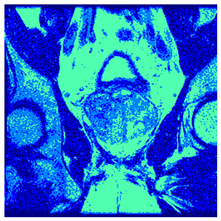 | 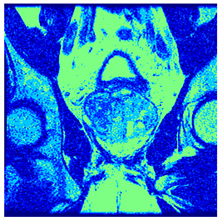 | 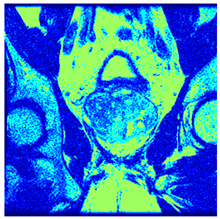 | 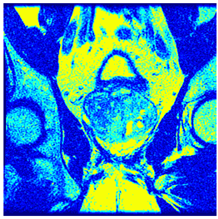 |
| 2 | 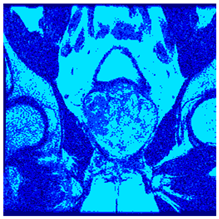 | 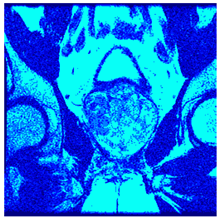 | 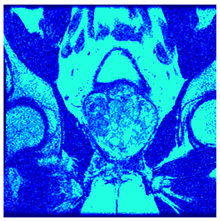 | 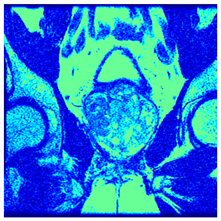 |
| 3 | 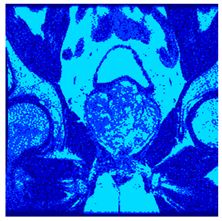 | 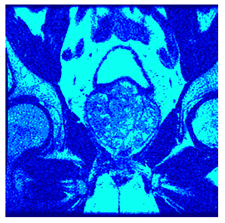 |  | 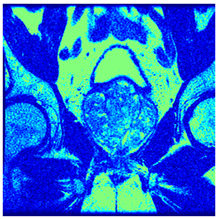 |
| 4 | 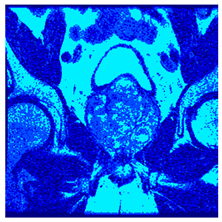 |  | 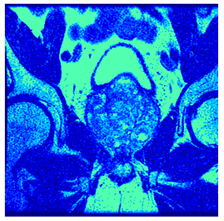 | 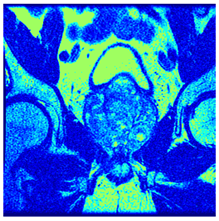 |
| 5 |  | 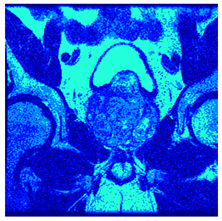 | 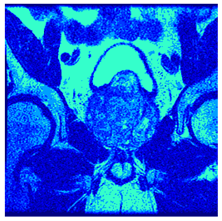 | 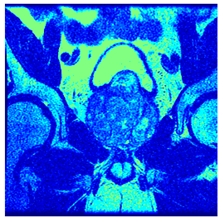 |
| 6 | 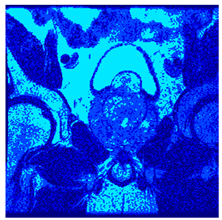 | 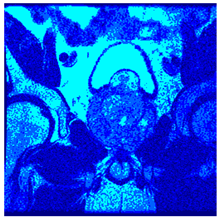 | 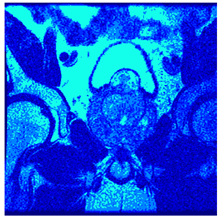 | 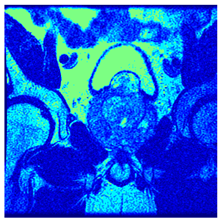 |
| 7 | 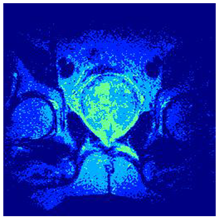 | 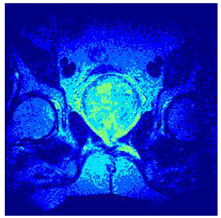 | 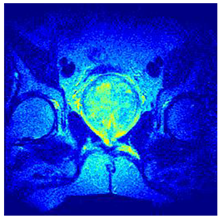 | 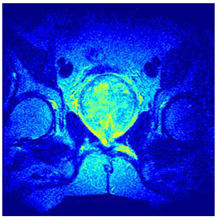 |
| 8 | 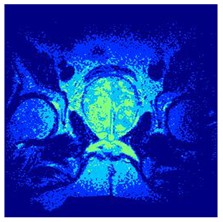 | 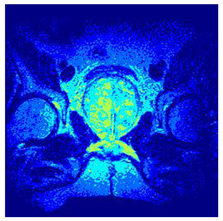 | 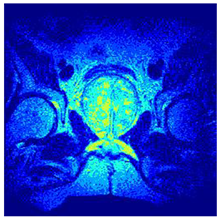 |  |
| 9 | 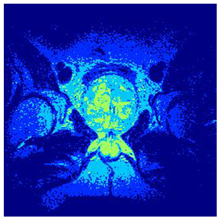 | 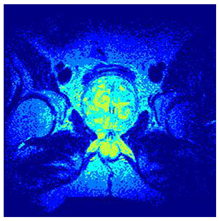 | 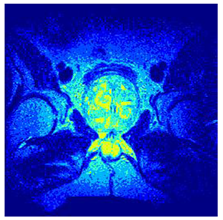 | 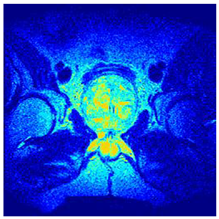 |
| 10 | 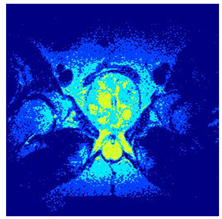 |  | 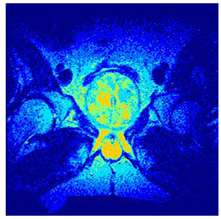 |  |
| 11 |  | 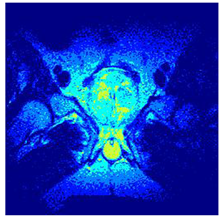 | 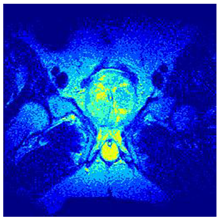 | 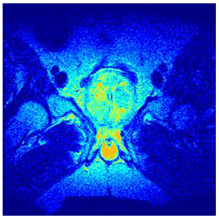 |
Disclaimer/Publisher’s Note: The statements, opinions and data contained in all publications are solely those of the individual author(s) and contributor(s) and not of MDPI and/or the editor(s). MDPI and/or the editor(s) disclaim responsibility for any injury to people or property resulting from any ideas, methods, instructions or products referred to in the content. |
© 2024 by the authors. Licensee MDPI, Basel, Switzerland. This article is an open access article distributed under the terms and conditions of the Creative Commons Attribution (CC BY) license (https://creativecommons.org/licenses/by/4.0/).
Share and Cite
Zarate, O.; Hinojosa, S.; Ortiz-Joachin, D. Improving Prostate Image Segmentation Based on Equilibrium Optimizer and Cross-Entropy. Appl. Sci. 2024, 14, 9785. https://doi.org/10.3390/app14219785
Zarate O, Hinojosa S, Ortiz-Joachin D. Improving Prostate Image Segmentation Based on Equilibrium Optimizer and Cross-Entropy. Applied Sciences. 2024; 14(21):9785. https://doi.org/10.3390/app14219785
Chicago/Turabian StyleZarate, Omar, Salvador Hinojosa, and Daniel Ortiz-Joachin. 2024. "Improving Prostate Image Segmentation Based on Equilibrium Optimizer and Cross-Entropy" Applied Sciences 14, no. 21: 9785. https://doi.org/10.3390/app14219785
APA StyleZarate, O., Hinojosa, S., & Ortiz-Joachin, D. (2024). Improving Prostate Image Segmentation Based on Equilibrium Optimizer and Cross-Entropy. Applied Sciences, 14(21), 9785. https://doi.org/10.3390/app14219785







